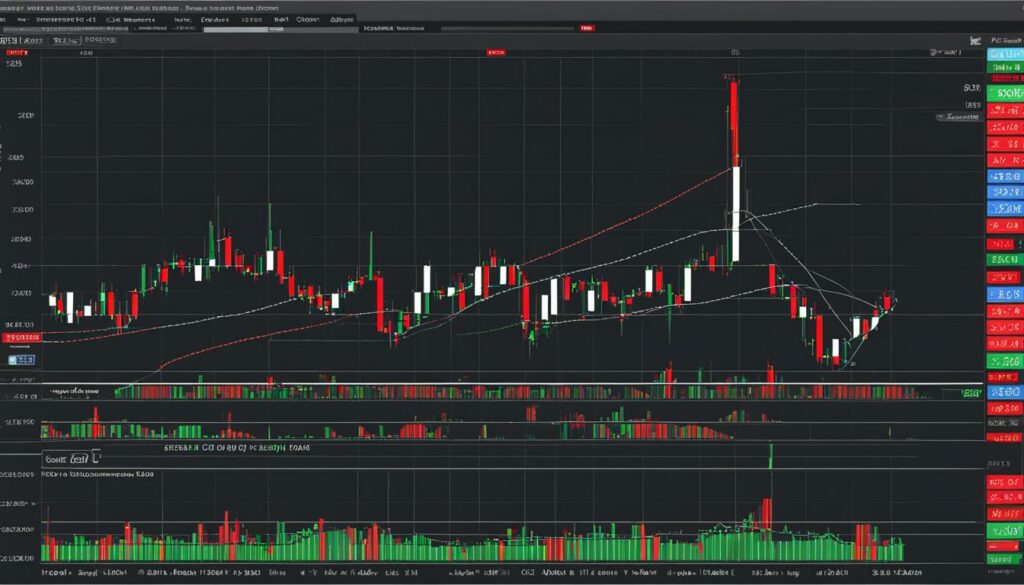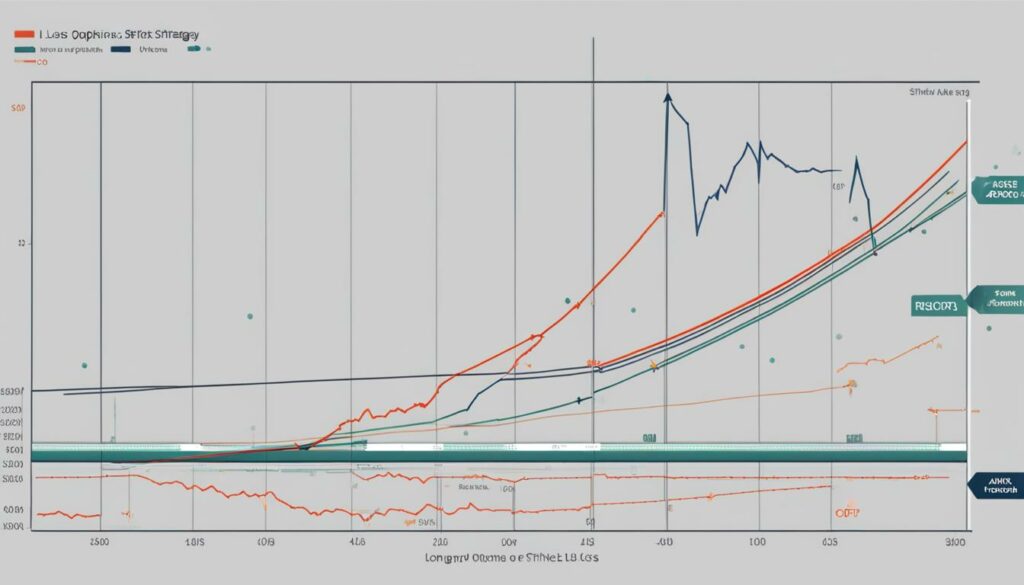Short Straddle Strategies: A Comprehensive Guide For Options Traders

Options trading strategies provide traders with a range of tools to navigate the complex world of financial markets. One such strategy is the short straddle, a versatile approach that can be used in neutral market conditions. In this comprehensive guide, we will explore the ins and outs of the short straddle strategy, highlighting its profit potential, risk management techniques, and the role it plays within the realm of options strategies.
Key Takeaways:
- The short straddle is an options trading strategy used in neutral market conditions.
- It involves selling both a call option and a put option with the same strike price and expiration date.
- The maximum profit for a short straddle is the premium collected, while the potential loss is unlimited.
- Risk management is crucial when implementing this strategy due to its unlimited risk.
- Understanding option pricing and volatility is essential for optimizing the profit potential of a short straddle.
Understanding Short Straddles
A short straddle strategy is designed to capitalize on the lack of movement in the underlying asset rather than predicting its direction. This options strategy involves selling both a call option and a put option with the same strike price and expiration date.
Traders collect premiums when they sell these options, with the goal of letting both options expire worthless. This allows traders to make a profit from the premium collected. However, there is always a risk of assignment if the underlying asset closes exactly at the strike price at expiration.
Advanced traders often employ this strategy when they anticipate a decrease in implied volatility. Instead of waiting until expiration, these traders may choose to close the position for a profit when the implied volatility decreases.
| Keyword | Description |
|---|---|
| Short straddle | An options strategy involving selling both a call and put option with the same strike price and expiration date |
| Lack of movement | The strategy aims to profit from stable market conditions where the underlying asset does not experience significant price movement |
| Premium | The price of the options sold, collected by the trader as profit |
| Expiration | The date when the options contract expires |
| Implied volatility | A measure of the market’s expectation of future volatility |
| Underlying asset | The security or financial instrument on which the options are based |
| Profit | The potential gain for the trader from selling the options |
| Advanced traders | Experienced options traders who possess a deep understanding of options strategies and market dynamics |
By understanding the mechanics of short straddle strategies, traders can gain an edge in navigating the complexities of options trading. However, it’s important for traders to assess their risk tolerance and have a solid grasp of implied volatility and the underlying asset’s behavior before implementing this advanced strategy.
Example of a Short Straddle
When implementing a short straddle strategy, traders often use at the money options. An at the money option is one where the strike price is close to the current price of the underlying stock. For example, let’s say a trader writes a short straddle with a strike price of $50 for an underlying stock that is currently trading at $50 per share. By doing so, the trader is obligated to sell the stock for $50 if the price jumps to $50. If the trader does not hold the underlying stock, they would need to buy it on the market for the higher price and sell it for $50, resulting in a loss.
The breakeven points for a short straddle are at the strike price plus or minus the total premium collected. In this example, if the trader collected a premium of $3 for selling both the call and put options, the breakeven points would be $53 and $47. If the stock price stays between these two points at expiration, the trader will break even. Any movement of the stock price beyond these breakeven points will result in potential profit or loss for the trader.
Note that the example given here is simplified for illustrative purposes. In reality, traders should carefully consider factors such as implied volatility, time decay, and risk management when implementing a short straddle strategy. Additionally, it is crucial to stay informed about market conditions and make adjustments to the position as necessary to mitigate potential risks and maximize profitability.

| Stock Price | Option Premium | Profit/Loss |
|---|---|---|
| Below $47 | Premium collected | Profit = Premium collected |
| $47 – $53 | Premium collected | Profit/Loss = Stock price – Strike price |
| Above $53 | Premium collected | Loss = Stock price – Strike price – Premium collected |
Risks of a Short Straddle
While the short straddle strategy has the potential for profit, it also comes with risks. As mentioned earlier, the potential loss for a short straddle is unlimited. If the stock price makes a significant move in either direction, the trader may face substantial losses. Additionally, if the stock price closes exactly at the strike price at expiration, there is a risk of assignment, requiring the trader to fulfill their obligations as per the options contract.
It’s important for traders to carefully assess their risk tolerance and have a solid risk management plan in place when considering the short straddle strategy. Monitoring the position closely, adjusting as necessary, and implementing appropriate risk mitigation strategies can help traders navigate the potential challenges and enhance the overall success of their options trading.
Is a Short Straddle Bullish?
A short straddle is a popular options trading strategy that combines elements of both bullish and bearish strategies. By selling both a call option and a put option with the same strike price and expiration date, traders are essentially betting on a narrow trading range for the underlying stock. This suggests a neutral market outlook.
The bullish aspect of a short straddle comes from the sale of the put option. By selling a put, the trader is obligated to buy the underlying stock at the strike price if it falls below that level. This indicates a bullish stance, as the trader believes the stock is unlikely to drop significantly in value.
On the other hand, the bearish element of a short straddle arises from the sale of the call option. By selling a call, the trader is obligated to sell the underlying stock at the strike price if it rises above that level. This indicates a bearish stance, as the trader believes the stock is unlikely to rise significantly in value.
| Short Straddle | Market Outlook |
|---|---|
| Bearish | Neutral |
| Bullish |
Understanding the Narrow Trading Range
When a trader implements a short straddle strategy, they are essentially expecting the underlying stock to trade within a relatively narrow range until expiration. This means they are not anticipating a big move in either direction. The objective is for both the call and put options to expire worthless, allowing the trader to keep the premium collected when selling the options.
However, it’s important to note that even though a short straddle can profit from a lack of movement in the underlying stock, it also comes with substantial risks. If the stock experiences a significant move beyond the strike price, the trader can face unlimited losses.
A short straddle combines elements of both bearish and bullish strategies, but the risks can be substantial if the underlying stock makes a big move.
Traders considering a short straddle should carefully assess their risk tolerance and market expectations before implementing this strategy. It is crucial to have a robust risk management plan in place to mitigate potential losses in the event of a significant price movement.
Is a Short Straddle or a Strangle Better?
When it comes to options strategies, both short straddles and strangles can be effective, but the choice between the two depends on the trader’s objective and market assessment. A short straddle is a strategy used when the trader expects low volatility and is uncertain about the direction of the stock price. By selling both a call option and a put option with the same strike price, the trader profits from the premium collected.
On the other hand, a strangle is a strategy used when the trader expects a significant move in the stock price but wants some protection. With a strangle, the trader buys both a call option and a put option, but with different strike prices. This allows for potential profit if the stock price moves in either direction, while also limiting the downside risk.
Ultimately, the decision between a short straddle and a strangle will depend on the trader’s assessment of the stock’s movement and their desired risk management. If the trader expects low volatility and wants to profit from stable market conditions, a short straddle may be the preferred strategy. However, if the trader expects a significant move in the stock price and wants some protection, a strangle may be more suitable.
Comparing Short Straddle and Strangle Strategies
Here is a comparative table outlining the key characteristics of short straddles and strangles:
| Strategy | Objective | Volatility | Risk |
|---|---|---|---|
| Short Straddle | Profit from low volatility and stable market conditions | Low implied volatility | Unlimited risk |
| Strangle | Profit from significant stock price moves | High implied volatility | Limited risk |
“The choice between a short straddle and a strangle depends on the trader’s assessment of the stock’s movement and their desired risk management.”
By considering these factors and understanding the differences between the two strategies, traders can make informed decisions and effectively utilize options strategies to achieve their investment goals.
What Is a Long Straddle?
A long straddle is an options trading strategy that involves buying both a put option and a call option with the same strike price and expiration date. Unlike a short straddle, which profits from low volatility and stable market conditions, a long straddle is designed to capitalize on significant price movements in the underlying asset. This strategy is often used when traders anticipate a big move in the stock price but are uncertain about the direction.
By purchasing both a put option and a call option, traders position themselves to profit regardless of whether the price goes up or down. The potential for a substantial gain comes from the increased volatility that often accompanies major market events or news. However, it’s important to note that a long straddle comes with higher risk than a short straddle. If the stock price remains relatively unchanged, both options may expire worthless, resulting in a loss for the trader.
Overall, a long straddle can be an effective strategy when traders anticipate a significant market event or news that could trigger a substantial move in the stock price. It allows them to profit from volatility while avoiding the need to predict the direction of the movement. However, it’s essential for traders to carefully consider the risks and manage their positions accordingly to maximize the potential for profit.

Example of a Long Straddle
To illustrate how a long straddle works, consider the following scenario:
Trader A believes that a major technology company is about to release a new product that could significantly impact its stock price. However, Trader A is uncertain whether the stock will go up or down as a result of the announcement.
In anticipation of the news, Trader A decides to execute a long straddle strategy. They buy both a put option and a call option on the company’s stock, both with a strike price of $100 and an expiration date one month from now. This means that regardless of whether the stock price goes above $100 or below $100, Trader A can profit.
If the stock price rises above $100, Trader A can exercise the call option, buying the stock at the strike price and then selling it at the higher market price. Conversely, if the stock price falls below $100, Trader A can exercise the put option, selling the stock at the strike price and then buying it back at the lower market price.
In either scenario, if the stock price remains relatively unchanged, both options may expire worthless, resulting in a loss for Trader A. However, the potential for a significant gain exists if the stock price experiences a big move in either direction.
| Stock Price | Call Option Profit/Loss | Put Option Profit/Loss | Total Profit/Loss |
|---|---|---|---|
| Above $100 | Positive | 0 | Positive |
| Below $100 | 0 | Positive | Positive |
| $100 | 0 | 0 | 0 |
Note: The table above demonstrates the potential profit or loss for each option and the total profit or loss based on different stock price scenarios.
The Bottom Line
A short straddle is an options trading strategy that involves selling both a call and put option. Traders collect premiums as profit from this strategy, but it is effective only in a market with low volatility. If the market experiences a significant move in either direction, the trader must cover any losses and give back the premium collected. Therefore, it is recommended for experienced traders who can effectively manage the risks associated with this strategy.
When implementing a short straddle, it is crucial to carefully assess the market conditions and volatility. Traders should look for periods of low volatility and stable market conditions, as this strategy profits from price stability. However, it is important for traders to be prepared for the potential risks involved, as a significant move in the market can result in substantial losses.
Risk management is paramount when executing a short straddle strategy. Traders should have a clear plan in place for managing potential losses and should always consider the impact of market volatility on the profitability of the strategy. Additionally, monitoring the market conditions and adjusting the position accordingly can help mitigate risks and maximize potential profits.
In conclusion, a short straddle can be a profitable options trading strategy in the right market conditions. However, it requires careful risk management, a thorough understanding of market volatility, and experience in executing options strategies. Traders should always be prepared for potential losses and adjust their positions accordingly to maximize their chances of success.
Strategy Discussion
The short straddle strategy is best suited for neutral or range-bound price action. Traders often use it between earnings reports or other announcements that can cause significant fluctuations in stock prices. By selling both the call and put options with the same strike price and expiration date, traders aim to profit from the lack of movement in the underlying asset.
When managing risk in a short straddle, it’s crucial to consider market consensus and timing. The market is often efficient, meaning that the prices of straddles generally reflect the expected price movement of the stock. Traders should carefully analyze the consensus view and look for opportunities to open the position at the right time.
To effectively close a short straddle position and maximize profitability, traders should monitor market volatility and the overall risk involved. It’s important to note that the potential losses in a short straddle are unlimited, so risk management is essential. Traders must be prepared to cover any losses and give back the premium collected if the market experiences a significant move in either direction.
Overall, the short straddle strategy requires careful analysis, market understanding, and effective risk management. By implementing these key elements, traders can enhance their chances of success when utilizing this neutral price action strategy.

Impact of Stock Price Change, Volatility, and Time
A short straddle strategy can be highly influenced by changes in stock price, volatility, and time decay. Understanding how these factors can impact the profitability of a short straddle is key to effectively managing risk and maximizing potential returns.
Stock Price Change
When it comes to stock price change, a short straddle is most profitable when the underlying stock remains stable and trades near the strike price. Small changes in the stock price near the strike price typically do not have a significant impact on the price of the straddle. However, if the stock price experiences a rapid increase or decrease, the short straddle can result in losses. Traders should be aware of this risk and consider implementing risk management techniques to limit potential losses.
Volatility Change
Volatility plays a crucial role in the profitability of a short straddle. High volatility generally leads to higher option premiums, making the sale of options more profitable. On the other hand, low volatility can reduce the potential profit from a short straddle. Traders should closely monitor volatility levels and adjust their strategies accordingly. It is also important to note that short straddles are generally best suited for low volatility environments, as they aim to profit from stable market conditions.
Time Decay
Time decay, also known as theta decay, can greatly impact the profitability of a short straddle. As time passes, the value of options decreases, especially as the expiration date approaches. This can work in favor of the seller of the options, as they can potentially buy back the options at a lower price or let them expire worthless. Traders should be aware of the time decay factor and consider their desired holding period for the short straddle strategy.
Overall, the impact of stock price change, volatility change, and time decay on a short straddle strategy should be carefully monitored and managed. Traders should analyze market conditions, assess the potential risks, and adjust their positions accordingly to enhance the overall success of utilizing the short straddle strategy.
Conclusion
The short straddle strategy is a popular options trading technique that offers profit potential in stable market conditions. However, it comes with the risk of unlimited losses. Traders who choose to implement this strategy must prioritize effective risk management to protect their capital.
By carefully monitoring market consensus and timing their trades, experienced traders can increase their chances of success with the short straddle. It is crucial to be aware of the impact of stock price changes, volatility, and time decay on the profitability of the strategy.
Options trading requires a thorough understanding of the market and its dynamics. Traders must consider the potential risks and rewards of each strategy, including the short straddle, before implementing them. It is advisable to practice sound risk management techniques and continuously monitor positions to optimize profit potential.
FAQ
What is a short straddle?
A short straddle is an options strategy in which a trader sells both a call option and a put option with the same strike price and expiration date. It is used when the trader expects the underlying asset to stay relatively stable and not experience significant price movement.
What is the maximum profit for a short straddle?
The maximum profit for a short straddle is the premium collected from selling the options.
What is the potential loss for a short straddle strategy?
The potential loss for a short straddle is unlimited.
Who is the short straddle strategy often used by?
The short straddle strategy is often used by more experienced traders due to its unlimited risk.
How do short straddles allow traders to profit?
Traders collect premiums when they sell the call and put options, with the goal of letting both options expire worthless.
What is the risk of assignment with a short straddle?
There is always a risk of assignment if the asset closes exactly at the strike price at expiration.
What options are often used when implementing a short straddle?
Traders often use at the money options when implementing a short straddle strategy.
What are the breakeven points for a short straddle?
The breakeven points for a short straddle are at the strike price plus or minus the total premium collected.
What does a short straddle combine?
A short straddle combines selling a call option, which is a bearish strategy, and a put option, which is a bullish strategy, with the same strike price and expiration date.
When is a short straddle strategy ideal?
A short straddle strategy is ideal when it’s unclear what direction the stock price will move in, as it profits from low volatility.
What is the difference between a short straddle and a strangle?
A short straddle is better when it’s unclear what direction the stock price will move in, while a strangle is better when the investor expects the stock price to move in a particular direction but wants some protection.
What is a long straddle?
A long straddle involves buying both a put option and a call option with the same strike price and expiration date, aiming to benefit from a significant move in the underlying asset’s price.
What should traders be aware of when using the short straddle strategy?
Traders should carefully manage their positions, consider market consensus, and be aware of the impact of stock price changes, volatility, and time on the profitability of the strategy.
What factors influence the profitability of a short straddle?
The profitability of a short straddle is influenced by changes in stock price, volatility, and time decay.







